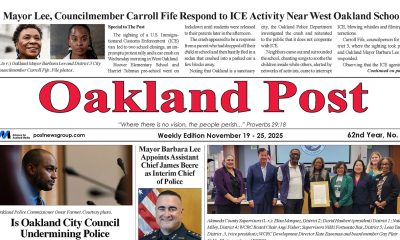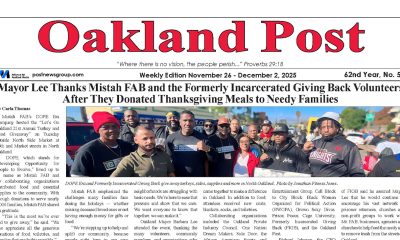Community
Cob Structures House Kitchen, Clinic, Shower, in West Oakland Homeless Community

Members of three organizations – Artists Building Communities, Essential Food and Medicine, and Living Earth Structures – have built a kitchen, clinic, free store, stage, toilet, oven, and shower with and for a homeless community near Wood Street in West Oakland.
Made out of wood covered in brown cob, the structures that house these facilities seem almost as natural extensions of the earth upon which they sit. Empty wine bottles serve as windows, and old discarded clothes serve as insulation. Sculpted images of trees decorate the structures’ surfaces and succulent plants sprout along the perimeters of their roofs.
Winding stone pathways connect the structures and are bordered by little gardens of herbs, greens, and flowers. The kitchen has a stove, sink with running water, shelving full of bread, and a refrigerator full of food. Herbs and emergency medical supplies fill the clinic. The shower’s water runs hot.
The project is called Cob on Wood. It sits on land owned by, west of Wood Street, and under the 880 freeway.
A community of homeless residents lives near Cob on Wood, surrounding the site. Advocates and some residents estimate the population of that community to be about 100 people. The area west of Wood Street in West Oakland that the community lives in does not receive regular sanitation service from the City of Oakland, and much of it is densely packed with abandoned vehicles and garbage.
With regular maintenance by those living inside and outside of the homeless community, the Cob on Wood site looks different from its surroundings, like a rose that grows out of a crack in the concrete.
“This was built through relationships with the community and came out of requests from the community,” said Xochitl Bernadette Moreno, co-founder of Essential Food and Medicine (EFAM).
EFAM started building relationships with Wood Street residents early in the COVID-19 pandemic by giving them juice, soups, and natural medicines made from local produce. Artists Building Community (ABC) also started early in the pandemic, when Annemarie Bustamante and some of her neighbors living in The Vulcan Loft apartments in East Oakland started building small wooden homes for homeless Oakland residents.
ABC has expanded now to include volunteers throughout the area, and they have built several of their homes in the Wood Street community. But the structures at Cob on Wood-look different from ABC’s homes.
ABC and EFAM came together to contract with Miguel Elliot of Living Earth Structures to guide the building of Cob on Wood structures using cob. The group benefited from Elliot’s experience of building cob structures for over 25 years in a variety of settings and locations, including parts of Central and South America, Africa, and Asia.
While the groups have followed Elliot’s construction guidance, they also followed nearby homeless residents’ service requests, whose first request was a kitchen. Elliot’s cob construction made the kitchen safe from catching fire, as the cob is fireproof.
Such precautions were necessary. Oakland’s fire department responded to almost 1,000 fires in homeless communities during fiscal years 2018-19 and 2019-20.
LeaJay Harper, who has lived in the Wood Street community for over seven years, now restocks the kitchen every few days and also cooks for herself and other residents.
“It’s been a challenge trying to keep food in the kitchen because people are definitely using it,” said Harper. “It’s made it so that folks who didn’t have the facilities at their own space to cook can have hot food every single day. A lot of people are gaining weight, which is a good thing.”
Harper works and meets closely with ABC and EFAM to plan food pickups. Other homeless residents have taken on roles in the community as well. A resident named Lydia, who lives in an RV near the community and is knowledgeable about medicinal uses of herbs, is the community clinic liaison. She helps spread information about ways residents can use the clinic’s herbs.
Raquel, a teenager who lives with her family in the Wood Street community, helps with outreach to inform other residents about Cob on Wood services and events. Another teenager, Sequoia, who used to live on Wood Street, is also part of Cob on Wood’s outreach team.
“I think being part of [Cob on Wood] is really amazing,” Sequoia said. “Most of my life I was homeless and being able to give back to the community now that I’m not on the streets means a lot to me.”
The idea for the community started in September of last year, and construction started in December. The project has been growing. These days, Moreno says about 50 people meet online on Wednesdays to formally plan and maintain the project.
On Sundays, the group meets more informally on site for construction, site maintenance, a pizza party, and an open mic. The vast majority of people involved with the project still live outside of the Wood Street community, but the word is spreading.
Cob on Wood volunteers go into the Wood Street community and hand out flyers about the project. On Sunday, April 18, they hosted an Earth Day celebration called “What’s Your Medicine?” with food, DJs, dance, and musical performances.
At least 100 people showed up to the event. One Wood Street resident who lives in a self-made home said he had never heard of Cob on Wood before but followed the sound of the music and found it.
Ashel Seasunz Eldridge, who co-founded EFAM, and performed at the Earth Day celebration with his band, Dogon Lights, said that Cob on Wood seeks to build on work that Wood St residents already are doing. During the Earth Day celebration, when Cob on Wood had a Town Hall to discuss how the project could sustain itself and better serve the community, five Wood Street residents took the lead, speaking to each other and the crowd through a PA system.
Those residents have been meeting weekly in another part of the Wood Street community.
“We were inspired by the meetings people were already having,” said Eldridge. “We thought, why not bring that to the town hall.”
One topic Wood Street residents spoke about was defending themselves and other people experiencing homelessness from displacement. It was something Cob on Wood organizers found pertinent, as they worry that the site, which sits on CalTrans owned land, could face displacement from that state agency.
A recent article in the San Francisco Chronicle cites CalTrans spokesperson RocQuel Johnson as claiming the agency plans to clear “abandoned vehicles and liter” from CalTrans land near Wood Street in May and June, claiming similar actions were executed on April 12 and April13.
ABC founder Annmarie Bustamante was at the Wood Street homeless community on those days and claims CalTrans forced people to move themselves and their homes from the location they lived to an area more out of sight of a nearby street.
Abandoned vehicles, Bustamante claims, were not removed from the Wood Street homeless community but were moved to a separate area still within that community. She said the operation did not remove trash but displaced people.
Although this reporter asked CalTrans about the April 12 and 13 operations, the agency did not respond. But Johnson told the SF Chronicle that “[Cob on Wood] structures were placed on state right of way without a permit or without safety inspections,” and added that “CalTrans is currently evaluating the best course of action and has no immediate plans to remove the structures.”
Cob on Wood organizers is unclear about whether CalTrans will remove their structures. The state agency cleared homeless people off their land in Oakland on Sept. 21 last year and late January this year. During the January operation, a group of advocates, 10 of whom carried colorful shields, defended the self-made home of two Oakland residents living on the land bordering Mosswood Park and the 580 Freeway.
While nearly 20 of their neighbors cleared themselves from the CalTrans-owned land they were living on, the two residents never left the area, and their home was not dismantled.
Bustamante, who was at the January CalTrans operation supporting eviction defense, is also prepared to defend Cob on Wood if necessary. Defending space through direct action is a topic of steady conversation among those involved with Cob on Wood.
“If CalTrans does try to displace us at Wood Street without allowing for other adequate resources, there’s gonna be a fight,” said Bustamante.
Cob on Wood wants to expand to include a sauna and small huts for homeless residents. They are seeking funds to help their project, to help pay for construction costs, materials and stipends for homeless residents who help with the project.
Readers can donate to their gofundme campaign.
Advice
Support Your Child’s Mental Health: Medi-Cal Covers Therapy, Medication, and More

Advertorial
When children struggle emotionally, it can affect every part of their lives — at home, in school, with friends, and even their physical health. In many Black families, we’re taught to be strong and push through. But our kids don’t have to struggle alone. Medi-Cal provides mental health care for children and youth, with no referral or diagnosis required.
Through California Advancing and Innovating Medi-Cal (CalAIM), the state is transforming how care is delivered. Services are now easier to access and better connected across mental health, physical health, and family support systems. CalAIM brings care into schools, homes, and communities, removing barriers and helping children get support early, before challenges escalate.
Help is Available, and it’s Covered
Under Medi-Cal, every child and teen under age 19 has the right to mental health care. This includes screenings, therapy, medication support, crisis stabilization, and help coordinating services. Parents, caregivers, and children age 12 or older can request a screening at any time, with no diagnosis or referral required.
Medi-Cal’s Mental Health and Substance Use Disorder Program
For children and youth with more serious mental health needs, including those in foster care or involved in the justice system, Medi-Cal offers expanded support, including:
- Family-centered and community-based therapy to address trauma, behavior challenges, or system involvement.
- Wraparound care teams that help keep children safely at home or with relatives.
- Activity funds that support healing through sports, art, music, and therapeutic camps.
- Initial joint behavioral health visits, where a mental health provider and child welfare worker meet with the family early in a case.
- Child welfare liaisons in Medi-Cal health plans who help caregivers and social workers get services for children faster
Keeping Kids Safe from Opioids and Harmful Drugs
DHCS is also working to keep young people safe as California faces rising risks from opioids and counterfeit pills. Programs like Elevate Youth California and Friday Night Live give teens mentorship, leadership opportunities, and positive outlets that strengthen mental well-being.
Through the California Youth Opioid Response, families can learn how to avoid dangerous substances and get treatment when needed. Song for Charlie provides parents and teens with facts and tools to talk honestly about mental health and counterfeit pills.
DHCS also supports groups like Young People in Recovery, which helps youth build skills for long-term healing, and the Youth Peer Mentor Program, which trains teens with lived experience to support others. These efforts are part of California’s strategy to protect young people, prevent overdoses, and help them make healthier choices.
Support for Parents and Caregivers
Children thrive when their caregivers are supported. Through CalAIM’s vision of whole-person care, Medi-Cal now covers dyadic services, visits where a child and caregiver meet together with a provider to strengthen bonding, manage stress, and address behavior challenges.
These visits may include screening the caregiver for depression or anxiety and connecting them to food, housing, or other health-related social needs, aligning with CalAIM’s Community Supports framework. Notably, only the child must be enrolled in Medi-Cal to receive dyadic care.
Family therapy is also covered and can take place in clinics, schools, homes, or via telehealth, reflecting CalAIM’s commitment to flexible, community-based care delivery.
Additionally, BrightLife Kids offers free tools, resources, and virtual coaching for caregivers and children ages 0–12. Families can sign up online or through the BrightLife Kids app. No insurance, diagnosis, or referral is required.
For teens and young adults ages 13–25, California offers Soluna, a free mental health app where young people can chat with coaches, learn coping skills, journal, or join supportive community circles. Soluna is free, confidential, available in app stores, and does not require insurance.
CalHOPE also provides free emotional support to all Californians through a 24/7 support line at (833) 317-HOPE (4673), online chat, and culturally responsive resources.
Support at School — Where Kids Already Are
Schools are often the first place where emotional stress is noticed. Through the Children and Youth Behavioral Health Initiative (CYBHI), public schools, community colleges, and universities can offer therapy, counseling, crisis support, and referrals at no cost to families.
Services are available during school breaks and delivered on campus, by phone or video, or at community sites. There are no copayments, deductibles, or bills.
Medi-Cal Still Covers Everyday Care
Medi-Cal continues to cover everyday mental health care, including therapy for stress, anxiety, depression, or trauma; medication support; crisis stabilization; hospital care when needed; and referrals to community programs through county mental health plans and Medi-Cal health plans.
How to Get Help
- Talk to your child’s teacher, school counselor, or doctor.
- In Alameda County call 510-272-3663 or the toll-free number 1-800-698-1118 and in San Francisco call 855-355-5757 to contact your county mental health plan to request an assessment or services.
- If your child is not enrolled in Medi-Cal, you can apply at com or my.medi-cal.ca.gov.
- In a mental health emergency, call or text 988, the Suicide and Crisis Lifeline.
Every child deserves to grow up healthy and supported. Medi-Cal is working to transform care so it’s accessible, equitable, and responsive to the needs of every family.
Activism
Ann Lowe: The Quiet Genius of American Couture
Lowe was born in Clayton, Alabama, into a family of gifted seamstresses. Her mother and grandmother were well-known dressmakers who created exquisite gowns for women in the area. By the time Lowe was a young girl, she was already showing extraordinary talent — cutting, sewing, and decorating fabric with a skill that far exceeded her age. When her mother died unexpectedly, Lowe – only 16 years old then – took over her mother’s sewing business, completing all the orders herself.

By Tamara Shiloh
Ann Cole Lowe, born Dec.14, 1898, was a pioneering American fashion designer whose extraordinary talent shaped some of the most widely recognized and celebrated gowns in U.S. history.
Although she designed dresses for society’s wealthiest families and created masterpieces worn at historic events, Lowe spent much of her life in the shadows — uncredited, underpaid, yet unmatched in skill. Today, she is celebrated as one of the first nationally recognized African American fashion designers and a true visionary in American couture.
Lowe was born in Clayton, Alabama, into a family of gifted seamstresses. Her mother and grandmother were well-known dressmakers who created exquisite gowns for women in the area. By the time Lowe was a young girl, she was already showing extraordinary talent — cutting, sewing, and decorating fabric with a skill that far exceeded her age. When her mother died unexpectedly, Lowe – only 16 years old then – took over her mother’s sewing business, completing all the orders herself. This early responsibility would prepare her for a lifetime of professional excellence.
In 1917, Lowe moved to New York City to study at the S.T. Taylor Design School. Although she was segregated from White students and forced to work separately, she, of course, excelled, graduating earlier than expected. Her instructors quickly recognized that her abilities were far above the typical student, especially her skill in hand-sewing, applique, and intricate floral embellishment – techniques that would become her signature.
Throughout the 1920s and 1930s, she designed gowns for high-society women in Florida and New York, operating boutiques and working for prestigious department stores. Her reputation for craftsmanship, originality, and elegance grew increasingly. She was known for creating gowns that moved beautifully, featured delicate hand-made flowers, and looked sculpted rather than sewn. Many wealthy clients specifically requested “an Ann Lowe gown” for weddings, balls, and galas.
Her most famous creation came in 1953: the wedding gown worn by Jacqueline Bouvier when she married Massachusetts Sen. John F. Kennedy. The dress – crafted from ivory silk taffeta with dozens of tiny, pleated rosettes – became one of the most photographed bridal gowns in American history. Despite this achievement, Lowe received no public credit at the time. When a flood destroyed her completed gowns 10 days before the wedding, she and her seamstresses worked day and night to remake everything – at her own expense. Her dedication and perfectionism never wavered.
She eventually opened “Ann Lowe Originals,” her own salon on New York’s Madison Avenue. She served clients such as the Rockefellers, DuPonts, Vanderbilts, and actresses like Olivia de Havilland. Yet even with her wealthy clientele, she struggled financially, often undercharging because she wanted every dress to be perfect, even if it meant losing money.
Lowe’s contributions were finally recognized later in life. Today, her exquisite gowns are preserved in museums, including the Smithsonian National Museum of African American History and Culture and the Metropolitan Museum of Art.
In the last five years of her life, Lowe lived with her daughter Ruth in Queens, N.Y. She died at her daughter’s home on Feb. 25, 1981, at the age of 82, after an extended illness.
Activism
2025 in Review: Seven Questions for Black Women’s Think Tank Founder Kellie Todd Griffin
As the president and CEO of the California Black Women’s Collective Empowerment Institute, Griffin is on a mission to shift the narrative and outcomes for Black women and girls. She founded the nation’s first Black Women’s Think Tank, securing $5 million in state funding to fuel policy change.

By Edward Henderson
California Black Media
With more than 25 years of experience spanning public affairs, community engagement, strategy, marketing, and communications, Kellie Todd Griffin is recognized across California as a leader who mobilizes people and policy around issues that matter.
As the president and CEO of the California Black Women’s Collective Empowerment Institute, Griffin is on a mission to shift the narrative and outcomes for Black women and girls. She founded the nation’s first Black Women’s Think Tank, securing $5 million in state funding to fuel policy change.
Griffin spoke with California Black Media (CBM) about her successes and setbacks in 2025 and her hopes for 2026.
Looking back at 2025, what stands out to you as your most important achievement and why?
Our greatest achievement in this year is we got an opportunity to honor the work of 35 Black women throughout California who are trailblazing the way for the next generation of leaders.
How did your leadership, efforts and investments as president and CEO California Black Women’s Collective Empowerment Institute contribute to improving the lives of Black Californians?
We’re training the next leaders. We have been able to train 35 women over a two-year period, and we’re about to start a new cohort of another 30 women. We also have trained over 500 middle and high school girls in leadership, advocacy, and financial literacy.
What frustrated you the most over the last year?
Getting the question, “why.” Why advocate for Black women? Why invest in Black people, Black communities? It’s always constantly having to explain that, although we are aware that there are other populations that are in great need, the quality-of-life indices for Black Californians continue to decrease. Our life expectancies are decreasing. Our unhoused population is increasing. Our health outcomes remain the worst.
We’re not asking anyone to choose one group to prioritize. We are saying, though, in addition to your investments into our immigrant brothers and sisters – or our religious brothers and sisters – we are also asking you to uplift the needs of Black Californians. That way, all of us can move forward together.
What inspired you the most over the last year?
I’ve always been amazed by the joy of Black women in the midst of crisis.
That is really our secret sauce. We don’t let the current state of any issue take our joy from us. It may break us a little bit. We may get tired a little bit. But we find ways to express that – through the arts, through music, through poetry.
What is one lesson you learned in 2025 that will inform your decision-making next year?
Reset. It’s so important not to be sitting still. We have a new administration. We’re seeing data showing that Black women have the largest unemployment rate. We’ve lost so many jobs. We can have rest – we can be restful – but we have to continue the resistance.
In one word, what is the biggest challenge Black Californians faced in 2025?
Motivation.
I choose motivation because of the tiredness. What is going to motivate us to be involved in 2026?
What is the goal you want to achieve most in 2026?
I want to get Black Californians in spaces and places of power and influence – as well as opportunities to thrive economically, socially, and physically.
-

 Activism4 weeks ago
Activism4 weeks agoIN MEMORIAM: William ‘Bill’ Patterson, 94
-

 Activism3 weeks ago
Activism3 weeks agoOakland Post: Week of November 19 – 25, 2025
-

 #NNPA BlackPress3 weeks ago
#NNPA BlackPress3 weeks agoBeyoncé and Jay-Z make rare public appearance with Lewis Hamilton at Las Vegas Grand Prix
-

 #NNPA BlackPress4 weeks ago
#NNPA BlackPress4 weeks agoLewis Hamilton set to start LAST in Saturday Night’s Las Vegas Grand Prix
-

 #NNPA BlackPress2 weeks ago
#NNPA BlackPress2 weeks agoLIHEAP Funds Released After Weeks of Delay as States and the District Rush to Protect Households from the Cold
-

 Alameda County2 weeks ago
Alameda County2 weeks agoSeth Curry Makes Impressive Debut with the Golden State Warriors
-

 Activism3 weeks ago
Activism3 weeks agoOakland Post: Week of November 26 – December 2, 2025
-

 #NNPA BlackPress2 weeks ago
#NNPA BlackPress2 weeks agoSeven Steps to Help Your Child Build Meaningful Connections














































